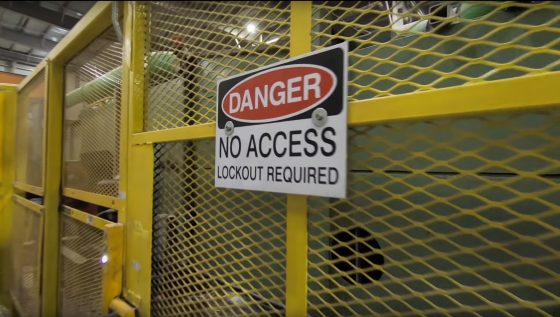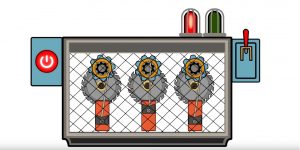Learn how managing risk and involving workers in safety planning are keys to safety for conveyor systems in manufacturing and other industries.

Photo credit: Still from WorkSafeBC video Kinetic Energy
Risk Management: Case Study
A worker at a B.C. wood products manufacturing plant was adjusting a waste conveyor after clearing the equipment of debris. The worker became entangled in the tails pool of the moving conveyor and was seriously injured.
This is just one of the incidents at B.C. workplaces involving conveyors. I spoke with Peter Yang, an occupational health and safety consultant with WorkSafeBC, to learn more about working safely around conveyor systems.
“It’s not that common, but when they do happen they can be really bad,” he says of incidents with conveyors. “They can be fatal or result in serious, permanent, life-changing injuries.”
Managing the risks
Conveyor systems are often used in wood and paper product manufacturing and in food and beverage processing. Conveyors are also used in many other manufacturing and non-manufacturing industries such as agriculture, recycling, warehousing, and retail.
Peter explains that safe operation of conveyors and other mechanized equipment involves managing risk. Safeguarding, de-energization, and lockout are key to controlling the risks with conveyors.
Proper safeguarding prevents workers from inadvertently touching or falling onto the moving parts of a conveyor. See this Safeguarding Machinery and Equipment manual that also includes a safeguarding checklist.

Lockout system
Photo credit: Still from WorkSafeBC video, ‘What Is Kinetic
Energy and What Are the Hazards?’
Lockout makes the equipment inoperable, protecting workers from coming into contact with hazardous parts if the equipment starts unexpectedly. It’s done in combination with de-energization, when safeguarding is disabled, removed, or bypassed, such as when maintenance or repairs are performed on the machine. De-energizing conveyors is important to prevent the often hidden kinetic energy or potential energy from injuring workers.
Involve workers in safety solutions
It’s not enough to have safety protocols in place. Employers also need to train, instruct, supervise, and communicate with workers about hazards and safety practices.
Be sure workers know about the hazards of gloves, necklaces, and long hair that can get caught in machinery and pull them in. Injuries can also happen when workers fall onto or near moving machinery, so it’s important to communicate the hazards of working and moving around, under, or above conveyors.
Cleaning staff need to be aware of the hazards and risks too. So do millwrights, electricians, and other outside contractors. In addition to workers who use conveyors daily, these other workers need to be trained and informed about safe work practices.
Peter suggests that employers involve workers who work with the conveyors when determining what safety solutions or new equipment will be put in place. “Employers need to know the work conditions and underlying reasons that might make workers want to circumvent safety procedures. Workers who interact with the equipment every day know what can and can’t work for specific tasks or situations.”
Employers can also get advice from others in the same industry. “Many workplaces tend to have similar challenges, so ask your peers what they did. Chances are, someone in your community has a safe and effective solution that’s compatible with your conveyors and operations. As always, due diligence and some customizations would still be needed,” Peter says.
For more information, see Avoid unsafe work practices around conveyors from Canadian Biomass magazine. You can also watch the video below to find out what one B.C. company is doing to protect their workers from kinetic energy risks around conveyors and other moving equipment.


